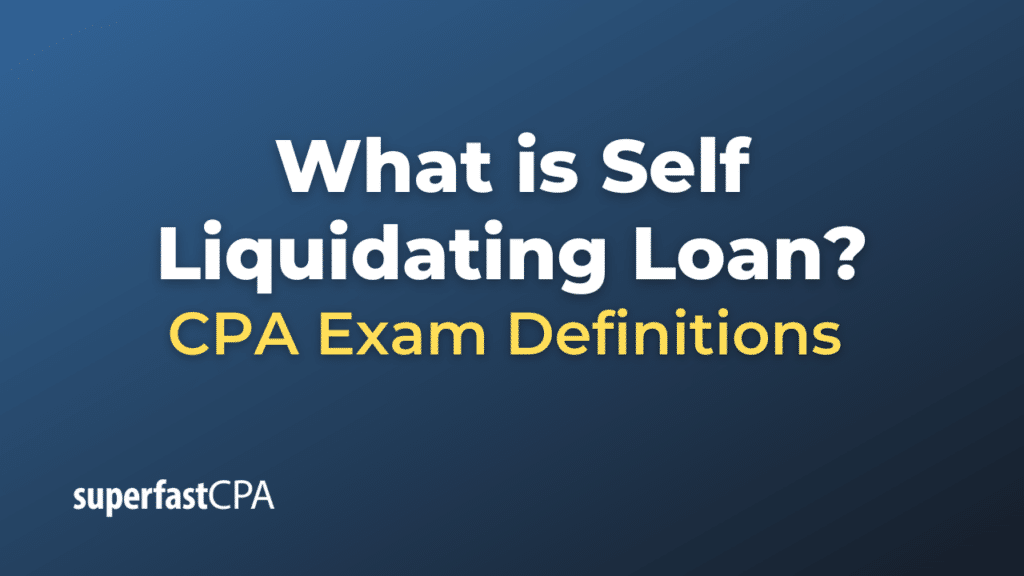Self Liquidating Loan
A self-liquidating loan refers to a type of short-term loan that is used to finance a specific transaction or period of operations with the expectation that the money generated from this transaction or operations will be used to repay the loan. Essentially, the proceeds or revenue from the activity financed by the loan will “self-liquidate” or repay the loan.
The term “self-liquidating” does not mean that the loan repays itself without the borrower’s intervention, but rather that the loan is taken out with the clear and specific plan that the revenues generated from what’s being financed will cover the loan repayment.
Examples of Self-Liquidating Loans:
- Inventory Financing:
- Scenario: A toy manufacturer expects a surge in sales during the holiday season and needs to produce more toys in October to meet the December demand. However, the manufacturer does not have the immediate funds to purchase the necessary materials.
- Self-Liquidating Loan: The manufacturer takes out a short-term loan in October to buy the materials, produces the toys, then sells them in December. The revenue from the December sales is then used to repay the loan taken out in October.
- Export-Import Financing:
- Scenario: An exporter in the U.S. has sold machinery to a buyer in Europe. The buyer is given 60 days to make the payment, but the exporter needs funds immediately for other operations.
- Self-Liquidating Loan: The exporter might obtain a short-term loan using the sales contract (or other instruments) as collateral. When the European buyer pays for the machinery 60 days later, the exporter uses those funds to repay the short-term loan.
- Real Estate:
- Scenario: A real estate developer wants to build a set of apartments. They believe that as soon as the apartments are completed, they can be sold quickly.
- Self-Liquidating Loan: The developer obtains a short-term construction loan to fund the building of the apartments. Once the apartments are sold, the proceeds from the sale are used to repay the loan.
The key to a successful self-liquidating loan is that the underlying transaction or operation (whether it’s selling goods, services, or property) must generate enough revenue to repay the loan. If for some reason the expected revenues do not materialize (e.g., the toys don’t sell as expected, the European buyer defaults, the apartments don’t sell quickly), then the borrower must find another way to repay the loan.
Example of Self Liquidating Loan
Let’s delve into a more detailed example to illustrate how a self-liquidating loan can work in a practical scenario.
Scenario: Anna’s Apparel
Anna owns a clothing store, “Anna’s Apparel,” located in a bustling city center. Every year, she notices a significant surge in sales during the summer months due to tourists and seasonal demand for summer wear. It’s now spring, and Anna wants to stock up on summer clothing to be well-prepared for the upcoming peak season.
However, Anna faces a challenge: She does not have enough capital on hand to buy the larger inventory she predicts she’ll need. After assessing her sales data from previous years, Anna estimates that she could earn a profit of $50,000 from the summer sales if she had a sufficient inventory.
Self-Liquidating Loan:
Anna approaches her bank and requests a short-term loan of $30,000 to purchase the summer inventory. She presents her sales data from previous years, her profit predictions, and a detailed plan of how she intends to utilize the loan. The bank agrees to offer her the loan at a 5% interest rate, to be repaid in 4 months, by the end of the summer.
Outcome:
- Anna uses the $30,000 loan to buy the summer inventory.
- Over the summer months, her prediction proves accurate. With her store stocked adequately, she manages to make sales that net her a profit of $50,000.
- At the end of summer, Anna repays the loan. The total repayment amount, including interest, is $30,000 + $1,500 (5% of $30,000) = $31,500.
- Anna’s net gain, after repaying the loan, is $50,000 – $31,500 = $18,500.
In this example, the loan Anna took out “self-liquidated.” The funds she borrowed were used to purchase inventory, and the revenue generated from selling that inventory was more than enough to repay the loan, leaving her with a profit. This exemplifies how businesses can leverage self-liquidating loans to capitalize on opportunities, even when they don’t have the necessary funds readily available.













